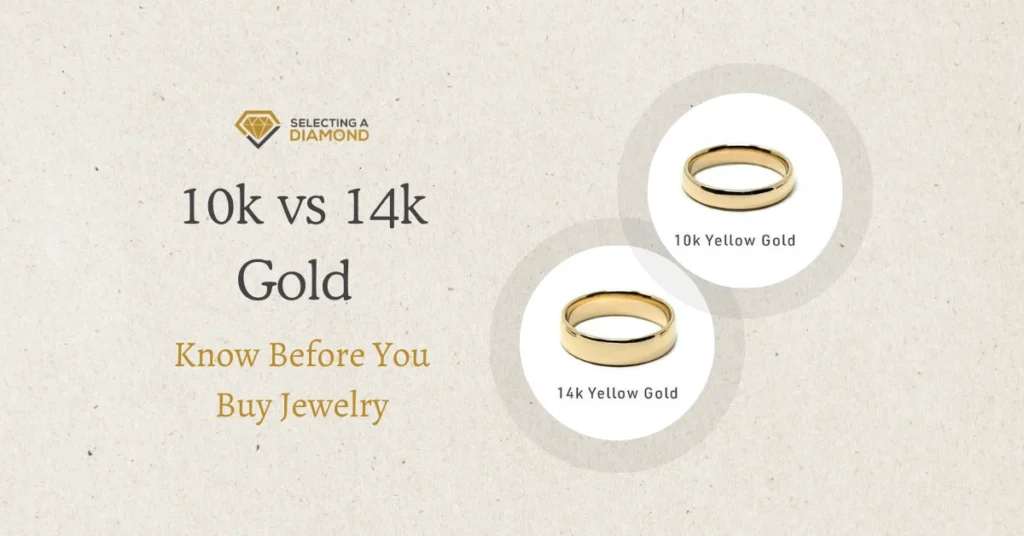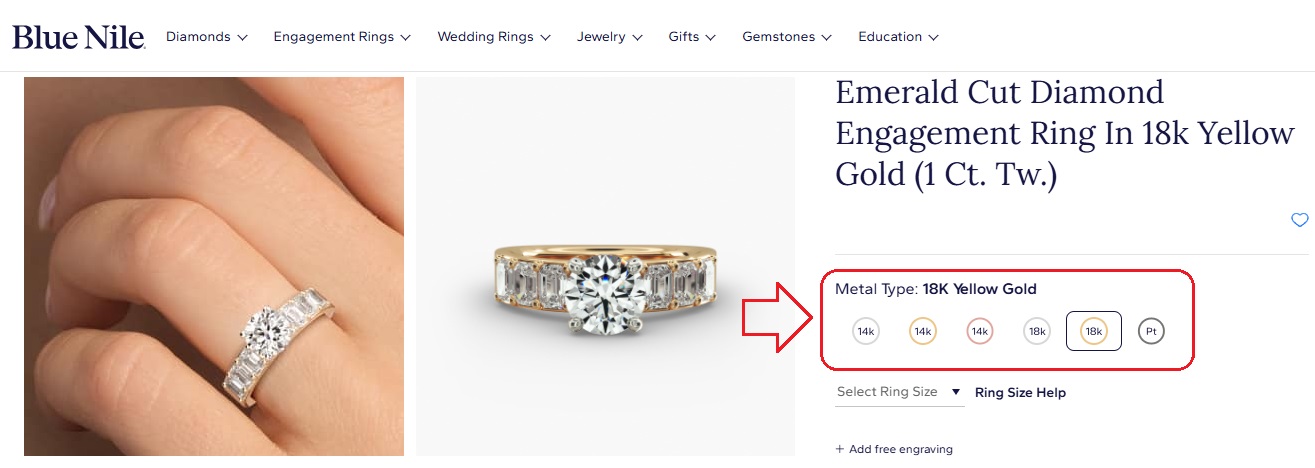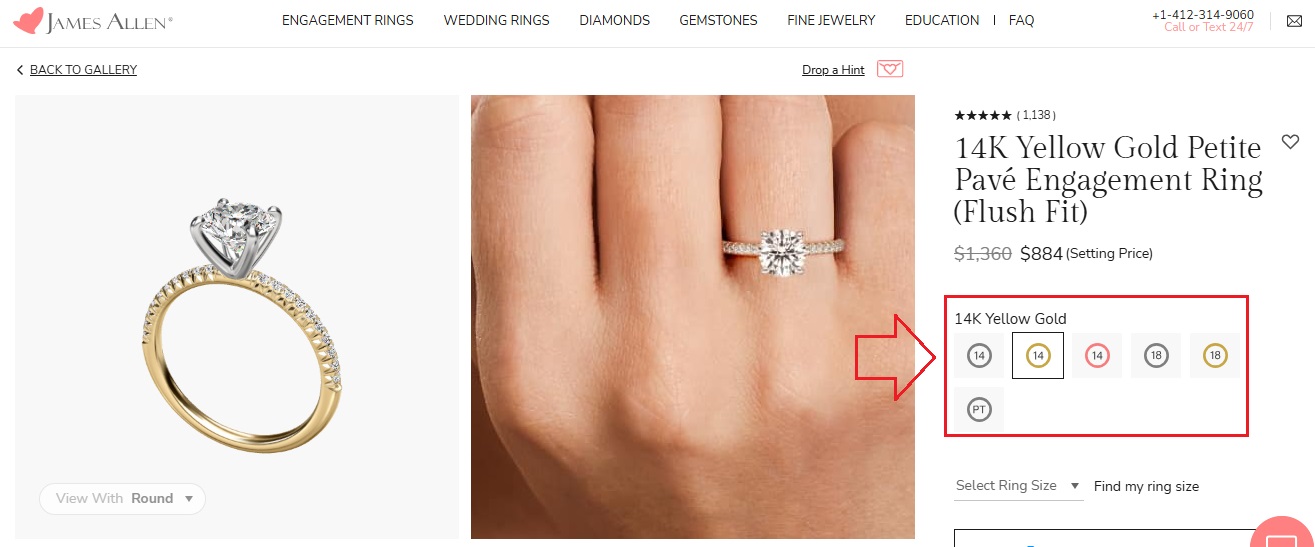We may earn a commission when you purchase through our affiliate links, at no extra cost to you. This helps support our work and allows us to continue providing unbiased, expert diamond advice.
If you’re buying gold jewelry, you’ll probably come across two common options: 10k vs 14k gold.
At first, they might look almost the same, but they’re not!
Each one has a different level of gold purity, price, and strength.
➡ In this article:
You’ll learn what “10k” and “14k” actually mean, how they compare in everyday use, and which one might be better for your lifestyle or budget.
Knowing the difference can help you make a smarter choice, and avoid regrets later.
Why Karat Differences Matter When Choosing Gold Jewelry
When you shop for gold jewelry, you might see numbers like 10k, 14k, or even 18k, these aren’t just random, they tell you how much real gold is in the piece.
That matters because gold is a soft metal, so it’s almost always mixed with stronger metals (like silver, copper, or nickel) to make it last longer.
The higher the karat, the more pure gold it contains, but more gold doesn’t always mean “better.”
Sometimes, lower-karat gold is tougher, which makes it better for things like everyday rings or bracelets that get bumped around a lot.
So when you’re choosing between 10k vs 14k gold, it’s not just about what looks good!
It’s about how much gold you want, how you’ll wear it, and how long you want it to last, that’s why karat differences really do matter.
What Does “K” in Gold Mean?
Let’s clear up something that confuses a lot of people:
karat and carat are not the same thing!
Yes! 👇
- Karat (K) is about how much pure gold is in a piece of jewelry.
- Carat (ct) is used to measure the weight of a gemstone, like a diamond.
So when you see 10k or 14k gold, the “K” stands for karat.
Gold is measured in 24 parts, so 24k gold is 100% pure gold.
But pure gold is very soft, which means it can bend, scratch, or lose its shape easily.
That’s why jewelers mix gold with other metals to make it stronger.
➡ For example:
- 10k gold = 10 parts gold + 14 parts other metals (41.7% gold)
- 14k gold = 14 parts gold + 10 parts other metals (58.3% gold)
This mixing process is called alloying, and it’s what gives gold different strengths, colors, and prices.
Understanding this helps you figure out which type of gold fits your lifestyle best, especially when comparing 10k vs 14k gold.
10k Gold Explained
10k gold is made up of 10 parts pure gold and 14 parts other metals, like copper, silver, or zinc.
As we mentioned above, that means it’s 41.7% gold, and the rest is added to make it stronger and more affordable.
Because of this mix, 10k gold is known for being very durable.
It’s harder than higher-karat gold, which makes it a great choice for everyday jewelry like rings, earrings, and chains, especially if you’re the type who wears the same piece all day, every day.
It’s also less expensive than 14k or 18k gold, which makes it appealing if you’re on a budget but still want real gold, not just gold-plated metal.
➡ The downside?
10k gold has less of that rich yellow glow, and some people with sensitive skin might react to the extra metals in the mix.
But overall, it’s a smart, tough, and budget-friendly option for daily wear, especially if you’re rough on your jewelry.
14k Gold Explained
14k gold means the jewelry is made of 14 parts pure gold and 10 parts other metals.
Also, as we explained above, that gives it a gold purity of 58.3%—so it has more real gold than 10k, but it’s still mixed with stronger metals to keep it durable.
This balance of gold and strength is one reason why 14k gold is the most popular choice, especially for engagement rings, wedding bands, and fine jewelry.
It has that classic gold look – bright and warm – without being too soft or too expensive.
➡ Another reason people love it?
It’s tough enough for daily wear, but it also feels more luxurious than 10k, it’s like getting the best of both worlds:
✅ Good quality
✅ Good value.
10k vs 14k Gold: Side-by-Side Comparison
When choosing between 10k vs 14k gold, it’s essential to understand how they differ in gold content, durability, color, and cost.
Here’s a straightforward comparison to help you make an informed decision:
-
Gold Content
- 10k Gold: Contains 41.7% pure gold and 58.3% other metals.
- 14k Gold: Contains 58.3% pure gold and 41.7% other metals.
This means 14k gold has more actual gold content, giving it a richer appearance and higher value.
-
Durability
- 10k Gold: More durable due to higher alloy content.
It’s harder and more resistant to scratches, making it suitable for everyday wear. - 14k Gold: Slightly softer because of higher gold content but still durable enough for regular use.
- 10k Gold: More durable due to higher alloy content.
If you’re hard on your jewelry or work with your hands, 10k gold might be the better choice for its toughness.
-
Color Differences
- 10k Gold: Has a paler, less vibrant yellow hue due to lower gold content.
- 14k Gold: Exhibits a warmer, more saturated yellow color, closer to pure gold.
The difference is subtle but noticeable, especially when comparing pieces side by side.
-
Cost and Value
As of April 12, 2025, the approximate market prices per gram are:
-
- 10k Gold: $43.35
- 14k Gold: $60.69
While 14k gold is more expensive, it offers a better balance of purity and durability, making it a popular choice for fine jewelry.
Concise Summary Table for 10K vs 14K Gold Comparison
| Feature | 10k Gold | 14k Gold |
|---|---|---|
| Gold Content | 41.7% pure gold | 58.3% pure gold |
| Durability | More durable, harder | Slightly softer, still durable |
| Color | Paler yellow tone | Warmer, richer yellow tone |
| Cost (per gram) | ~$43.35 (as of April 2025) | ~$60.69 (as of April 2025) |
| Best For | Budget-friendly, everyday wear | Balanced quality and appearance |
Which One Is Better for Everyday Wear?
If you’re planning to wear your jewelry every day, like a ring you never take off or a bracelet you sleep in, toughness really matters.
Because 10k gold has more other metals mixed in, it’s harder and more scratch-resistant than 14k.
That makes it a great choice for people with busy, hands-on lifestyles, like if you work with tools, cook a lot, or don’t want to worry about babying your jewelry.
On the other hand, 14k gold is still strong enough for most people’s daily use, but it has a slightly higher gold content, which also makes it a bit softer.
If your job doesn’t involve a lot of rough hand use, or if you’re someone who takes jewelry off while working, 14k gold will hold up just fine—and look a little richer in color.
So when it comes to everyday wear, ask yourself:
- Do I want something I never have to think about? → Go for 10k
- Do I want a mix of beauty and durability? → Go for 14k
Either way, knowing your daily habits helps you pick a piece that won’t just look good, it’ll last.
Which One Looks Better? Color and Appearance
Both 10k and 14k gold can look beautiful, but they don’t look exactly the same.
Because 14k gold has more pure gold in it, it usually has a richer, warmer color.
It gives off that classic yellow-gold shine most people expect.
On the other hand, 10k gold has more alloy metals, which gives it a slightly lighter and less yellow tone.
The difference isn’t huge, but if you hold them side by side, you’ll probably notice it.
➡ Now, when it comes to how the gold looks on you, your skin tone can make a difference too:
- If you have warm undertones (your skin looks better in earth tones or gold jewelry), you might really love the deeper color of 14k gold.
- If you have cool or neutral undertones (you look better in silver or blue-based colors), you might find that the lighter shade of 10k gold works better for you.
Of course, there’s no rule, you should go with the one that looks best to you.
But if color is important in your decision between 10k vs 14k gold, this subtle difference could help you decide.
Allergies and Skin Sensitivity: Which Gold Type Is Gentler?
If you have sensitive skin or you’ve ever gotten an itchy rash from wearing jewelry, this part is important.
Not all gold is the same when it comes to skin reactions.
👉 Here’s why:
Pure gold usually doesn’t cause allergies, but gold jewelry is rarely 100% pure.
Both 10k and 14k gold are mixed with other metals, like nickel, copper, or zinc, to make the jewelry stronger.
And sometimes, it’s those metals that cause skin irritation.
Since 10k gold has less gold and more other metals, it’s a bit more likely to cause a reaction if you’re allergic to something like nickel.
14k gold has more pure gold, so it’s usually gentler on the skin and a safer choice for people with sensitivity.
If you’ve had trouble with certain jewelry before, or if you’re buying a gift for someone with known allergies, choosing 14k gold is usually the better bet.
Or you can look for nickel-free options and check with trusted jewelers like James Allen or Blue Nile, who offer higher quality and clearer material info.
Popular Jewelry Types by Karat
Both 10k and 14k gold are used in all kinds of jewelry, but some pieces work better in one karat than the other, depending on how and where you wear them.
-
Rings (Especially Everyday Rings)
To reiterate, 10k gold is a great choice for rings you wear every day, like casual bands or promise rings.
It’s tougher and less likely to scratch, which is helpful if you’re always using your hands.
14k gold is more common for engagement rings and wedding bands.
It still holds up well, but it also gives you that richer gold color people often want for something special.
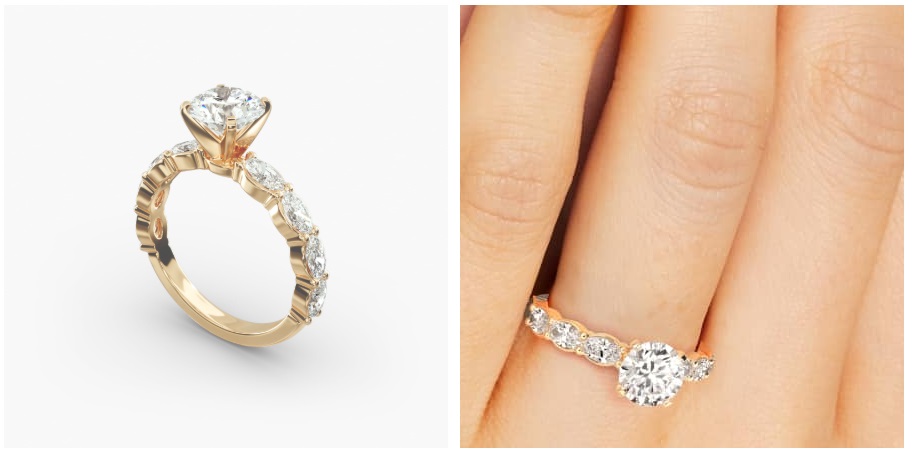
-
Earrings
Both 10k and 14k gold work well for earrings, but if you have sensitive ears, 14k is usually the safer bet, it’s gentler on the skin and less likely to cause irritation.
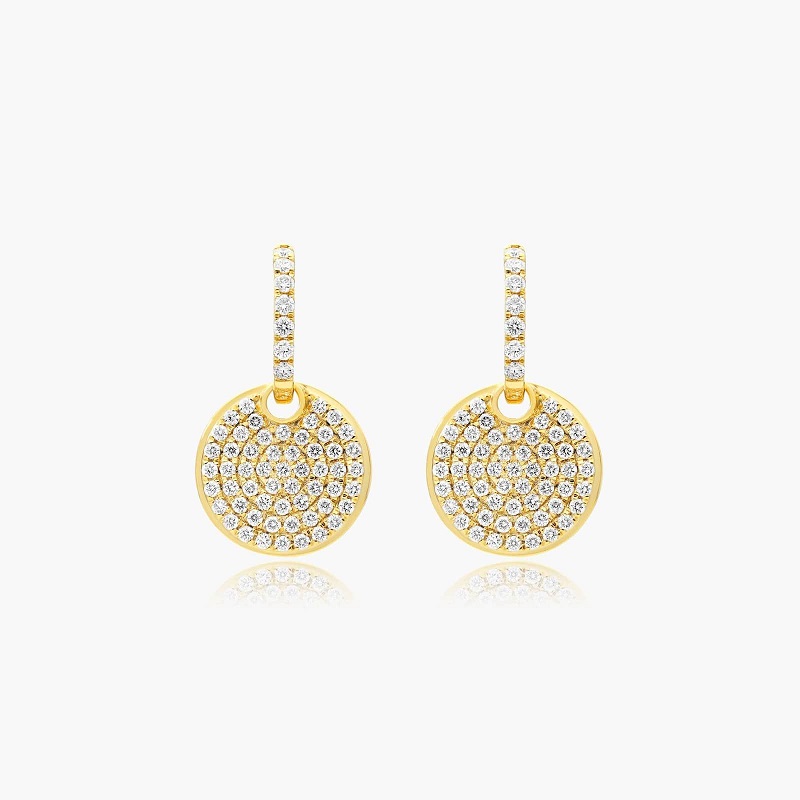
You might be interested in:
What is The Best Size for Diamond Stud Earrings?
-
Necklaces and Pendants
If you’re wearing a necklace every day, 10k gold can be a durable and budget-friendly option.
For pieces you take off at night or wear for dressier occasions, 14k gold adds a bit more shine and luxury.
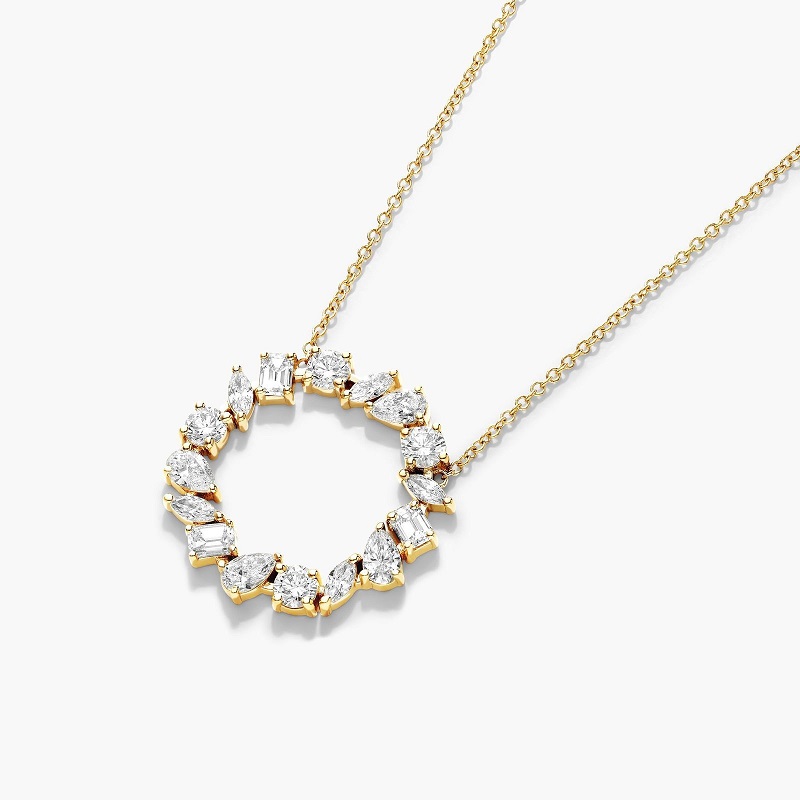
-
Bracelets
Bracelets tend to get bumped and scratched throughout the day, so 10k gold is often preferred for daily wear.
If you’re looking for a more polished look or a gift piece, 14k gold makes the bracelet feel more refined without being too delicate.
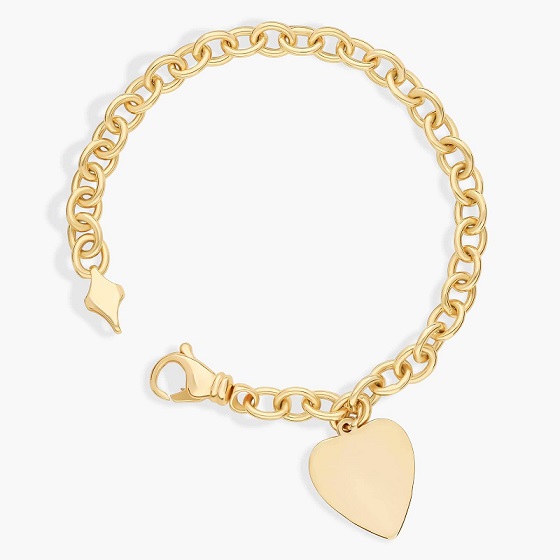
➡ The good news?
Both types of gold can be used for any kind of jewelry, you just have to think about how often you’ll wear it, how careful you are with your pieces, and what feels right for your style and budget.
What Do Jewelers Recommend?
When you browse well-known jewelers like James Allen or Blue Nile, you might notice something interesting…
They don’t offer 10k gold at all!
Why?
Because they focus on offering pieces that are higher in quality, more beautiful in appearance, and made to last.
14k gold hits a sweet spot, it has enough pure gold to give that rich, warm look people want, but it’s still strong enough for daily wear.
It also tends to cause fewer skin reactions, which makes it a safer option for more people.
That’s why jewelers who care about long-term value – not just quick sales – usually recommend 14k.
It gives you durability, comfort, and a premium look without going all the way up to the higher cost of 18k or 22k.
So if you’re buying something meaningful, like a ring you’ll wear every day or a gift that should last, 14k gold is the trusted standard.
And when top retailers focus on it, it’s not just for show, it’s because it’s proven to deliver beauty and quality over time.
Conclusion
When it comes to 10k vs 14k gold, there’s no one-size-fits-all answer, just the one that fits you.
Here’s what to remember:
10k gold is tougher, more affordable, and great for everyday pieces that take a lot of wear and tear.
14k gold has more pure gold, looks richer, and is better for people with sensitive skin or anyone wanting a balance of beauty and durability.
If you’re on a tight budget, 10k gold can be a smart choice, especially for casual rings, bracelets, or necklaces.
But if you’re buying something more meaningful (like a wedding band or a gift), or you want a look that’s closer to pure gold, 14k gold offers better long-term value.
➡ In the end:
Choose what fits your lifestyle, comfort, and style, whether that’s strength, shine, or something in between.

